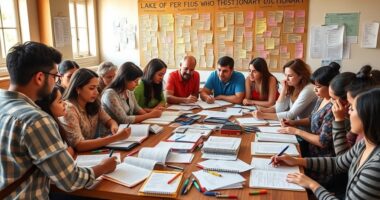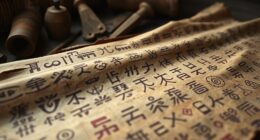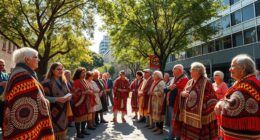The Pama–Nyungan family is Australia’s largest language group, with over 300 Indigenous languages spoken across the continent and Tasmania. These languages share common structures and roots, serving as crucial links to Aboriginal culture, stories, laws, and land knowledge. They demonstrate remarkable resilience and diversity, reflecting the rich cultural heritage of Indigenous communities. To learn more about how these languages continue to shape Australia’s identity, keep exploring their fascinating history and ongoing revitalization efforts.
Key Takeaways
- Pama–Nyungan is Australia’s largest language family, comprising over 300 languages across mainland Australia and Tasmania.
- These languages share common grammatical features and vocabulary roots, reflecting their cohesive linguistic heritage.
- They encode rich cultural knowledge, including stories, laws, ceremonies, and environmental information vital to Indigenous communities.
- Ongoing preservation and revitalization efforts sustain these languages, reinforcing cultural identity and intergenerational connection.
- The diversity within Pama–Nyungan highlights the resilience and adaptability of Australia’s Indigenous peoples and their cultural legacy.

Have you ever wondered which language group is the largest in Australia? If so, you’re about to discover that the Pama–Nyungan families hold that distinction. This vast collection of languages covers most of the continent, making it the dominant linguistic group in the country. The significance of Pama–Nyungan isn’t just in its size; it also plays a fundamental role in shaping Australia’s rich cultural heritage. As you explore this language family, you’ll find a fascinating blend of diversity and history that reflects the continent’s ancient roots.
The linguistic diversity within the Pama–Nyungan families is remarkable. It encompasses over 300 individual languages, spoken by Indigenous communities spread across the mainland and Tasmania. Despite the differences in dialects and pronunciation, these languages share common grammatical structures and vocabulary roots, linking them together into a cohesive family. This linguistic variety highlights the adaptability and resilience of Australia’s original peoples, who have maintained their languages through generations despite colonial pressures and modernization. Recognizing the scope of this diversity helps you appreciate the depth of cultural expression embedded in these languages.
Understanding the cultural heritage embedded in the Pama–Nyungan languages offers a window into the histories and traditions of Aboriginal Australians. Each language carries stories, laws, ceremonies, and knowledge about the land—elements that are essential to maintaining cultural identity. When you learn about these languages, you’re fundamentally engaging with a living history that preserves centuries of cultural practices. Many of these languages encode detailed information about the environment, such as river systems, plant species, and animal behaviors, which underscores their importance in traditional life. Additionally, language preservation efforts play a crucial role in supporting the survival and revitalization of these vital languages. The survival of these languages today is intertwined with efforts to preserve and revitalize Indigenous culture, ensuring that future generations can connect with their ancestral roots.
Furthermore, the linguistic diversity within the Pama–Nyungan families demonstrates how language reflects cultural resilience. Despite the impacts of colonization, many communities continue to speak, teach, and rejuvenate their languages. This ongoing effort plays a necessary role in maintaining cultural heritage, fostering community pride, and passing down knowledge. As you explore the Pama–Nyungan family, you see not just a collection of languages but a testament to the enduring spirit of Australia’s Indigenous peoples. These languages are more than communication tools—they are living symbols of identity, history, and cultural continuity that shape the unique fabric of Australia’s heritage.
Frequently Asked Questions
How Do Pama–Nyungan Languages Influence Modern Australian Culture?
You see how Pama–Nyungan languages influence modern Australian culture through cultural influence and language integration. These languages shape Indigenous art, storytelling, and place names, enriching national identity. When you hear Aboriginal words in everyday life or see them in media, it’s a proof to ongoing language integration. This connection fosters respect, awareness, and appreciation of Indigenous heritage, making Australia’s culture more diverse and inclusive.
Are There Efforts to Revive or Preserve Endangered Pama–Nyungan Languages?
Ever wondered how communities are fighting to save endangered Pama–Nyungan languages? Yes, many are actively involved in language revitalization and community efforts to keep these languages alive. You can see programs teaching children, recording elders, and promoting use in daily life. These initiatives foster pride and make certain these rich linguistic traditions aren’t lost forever. Isn’t it inspiring to see communities working hard to preserve their cultural heritage?
What Are the Main Challenges in Studying Pama–Nyungan Language History?
You face challenges in studying Pama–Nyungan language history due to its linguistic complexities and limited written records. These complexities make it hard to trace language evolution accurately. Additionally, you rely on archaeological correlations, which can be inconclusive or inconsistent. This combination of intricate language features and scarce historical data hampers efforts to fully understand how these languages developed over time.
How Do Pama–Nyungan Languages Relate to Other Indigenous Australian Languages?
You’ll find that Pama–Nyungan languages are like a vast, interconnected web in linguistic classification, sharing roots and features with other Indigenous Australian languages. While they’re the largest family, you’ll notice language borrowing has played a big role, creating similarities across groups. This interconnectedness shows a complex history of contact and evolution, making it fascinating to trace how different languages influence each other within Australia’s diverse linguistic landscape.
What Role Do Pama–Nyungan Languages Play in Indigenous Identity Today?
You play a crucial role in cultural preservation and strengthening language identity through Pama–Nyungan languages today. These languages serve as a powerful link to your ancestors, shaping your cultural pride and community bonds. By learning, speaking, and passing on these languages, you help guarantee their survival, fostering a deeper connection to your heritage and reinforcing the importance of indigenous identity in contemporary Australia.
Conclusion
As you walk through the vibrant tapestry of Pama–Nyungan languages, imagine each one as a colorful thread woven into Australia’s cultural fabric. Just like a single drop of water can fill an ocean, these languages hold stories and traditions that sustain the land’s identity. Preserving them is like tending a mighty tree—each branch and leaf essential for its strength. Keep exploring and supporting, for their future depends on your connection to this rich linguistic heritage.
Mary is a passionate writer who brings creativity and a fresh perspective to our team. Her words have the power to captivate and inspire, making her an essential contributor to our content. Mary’s commitment to storytelling and dedication to promoting Indigenous culture ensures that her work touches the hearts of our readers. We’re fortunate to have her as part of our team.










